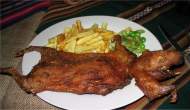Guinea Pigs
Guinea pigs are rodents belonging to the family Caviidae and the genus Cavia. Despite their common name, these animals are not pigs, nor do they come from Guinea. They are originally native to the Andes, and while they are no longer extant in the wild, they are closely related to several species which are commonly found in the grassy plains and plateaus of the region. The guinea pig plays an important role in the folk culture of indigenous South Americans, especially as a food source, but also in folk medicine and in community religious ceremonies. Since the 1960s, efforts have been made to increase consumption of the animal outside South America.

In Western societies, the guinea pig has enjoyed widespread popularity as a household pet since its introduction by European traders in the sixteenth century. Because of its docile nature, the relative ease of caretaking, and its responsiveness to handling and feeding, the guinea pig remains a popular pet choice.
"Guinea pig" is also used as a by-word in English for a subject of experimentation; this usage became common in the first half of the twentieth century. Biological experimentation on guinea pigs has been carried out since the seventeenth century; the animals were frequently used as a model organism in the nineteenth and twentieth centuries, but have since been largely replaced by other rodents such as mice and rats. They are still used in research, primarily as models for human medical conditions such as juvenile diabetes, tuberculosis, scurvy, and pregnancy complications.
Read more! Wikipedia
